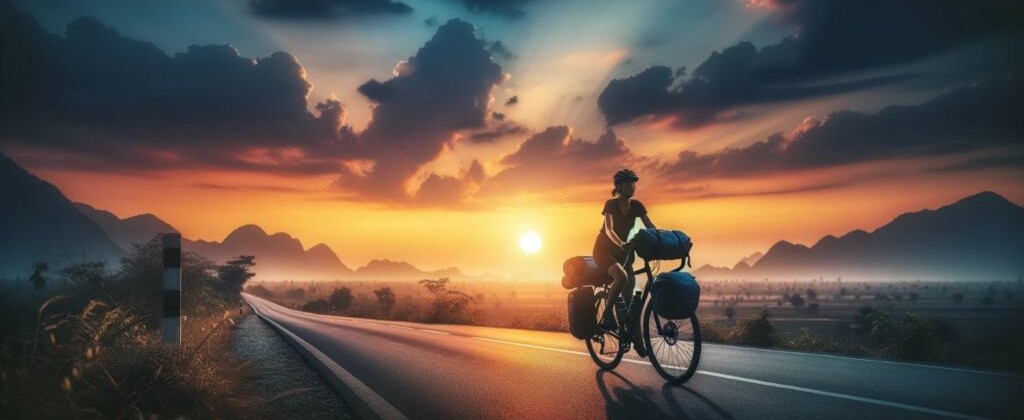Introduction: The Adventure Begins with a Line on a Map
Every great bikepacking journey starts not on the trail, but in the quiet moments of planning. It begins as an idea, a dream of a distant landscape that slowly takes shape as a line on a map. This process is more than just logistics; it is the first act of the adventure itself. Thoughtful route planning transforms a simple ride into a meaningful exploration, opening the door to stunning landscapes, hidden gems, and a deeper connection with the world around you. It is the craft of turning a dream into a journey.
Reading the Land: Understanding the Terrain
A map tells a story about the land you will travel. Learning to read this story is a fundamental skill for a bikepacker. The terrain dictates the rhythm of your journey, the effort you will expend, and the type of experience you will have.
The Surface Beneath Your Wheels: The ground itself has a voice. Smooth pavement allows for fast, efficient travel, letting you cover great distances. Gravel roads invite a slower pace, a chance to hear the crunch of stones and feel more connected to the path. Rugged singletrack trails demand your full attention, transforming the ride into a dance between you, your bike, and the earth. Understanding the mix of these surfaces helps you choose the right bike and plan a realistic daily mileage.
The Story of Elevation: An elevation profile is a picture of your challenge and your reward. The climbs are the heart of the journey, testing your strength and resolve. Each ascent is an investment, and the summit pays you back with breathtaking views and the thrilling gift of a long descent. A route with significant climbing is a journey into the sky, while a flatter path is a meditation on forward motion.
The Lifeblood of Your Journey: Water and Resupply
Bikepacking teaches a beautiful lesson in self-sufficiency. Managing your food and water connects you to the basic, essential needs of life and to the landscape that provides for you.
Finding and Carrying Water: Water is life. Before you leave, study your map to identify towns, campgrounds, and natural sources like streams or springs. In dry climates, you may need to carry many liters, and there are creative ways to do so. A hydration bladder in a frame bag keeps the weight low and centered, while extra bottles can be mounted on your fork or handlebars. Always treat water from natural sources with a filter or purifier to keep yourself healthy and strong.
Fueling the Engine: Food is the fuel for your adventure. The distance between towns will determine how much you need to carry. Focus on lightweight, high-calorie foods that pack easily. Nuts, dried fruits, energy bars, and simple grains are the staples of a bikepacker's pantry. Planning your resupply stops is a key part of your strategy, a welcome rhythm of venturing out and returning to the comfort of a small-town grocery store.
Navigating the Worlds of People and Nature
Your route will likely guide you through a variety of environments, from the bustling energy of a city to the quiet solitude of the wilderness. Each requires a different approach.
The Urban Passage: Navigating a city on a loaded bike can feel like a challenge, but it is a manageable one. Look for dedicated bike lanes and cycle-friendly roads. Many cities offer cycling maps that reveal these safer corridors. Navigation apps like OsmAnd are wonderful tools for finding your way through complex street networks. Sometimes, the best route is found by asking a local cyclist, who can share the secrets of their city.
Embracing the Wild: Rural and remote landscapes offer a deep sense of peace and connection. This is where the feeling of true exploration comes alive. These areas require greater self-sufficiency. Services are few and far between, so you must carry what you need. The roads may be rough and unpaved. This is a time to embrace the solitude, to listen to the sounds of nature, and to know that you have the skills and preparation to travel with confidence.
A Circle of Safety: Traveling with Awareness
True freedom on the trail comes from a foundation of safety. Being prepared allows you to relax and fully immerse yourself in the experience.
Backcountry Preparedness: When you are far from help, you are your own first responder. Always share your route with someone at home. Carry a paper map and compass as a backup to your GPS device. In areas with no cell service, a satellite messenger can be a lifeline in an emergency. Be aware of the wildlife in the region and know how to store your food safely. A small first-aid kit can help you manage minor injuries and keep them from becoming bigger problems.
Visibility and Traffic: When your route includes roads with cars, make yourself seen. Use bright, flashing lights, even during the day. Wear colorful clothing. Ride predictably and follow all traffic laws. Your awareness and visibility are your best tools for staying safe in traffic.
Conclusion: The Path Unfolds
Planning your route is an act of imagination. You are creating the blueprint for a future memory. You are charting a course through landscapes both external and internal. Embrace this process. Let it build your excitement and your confidence. The research, the preparation, the lines drawn on a map—they are all part of the journey. And when the time comes to finally pedal away, you will ride with the quiet assurance that you are ready for the beautiful, unfolding path ahead.

